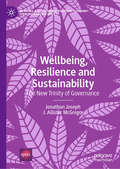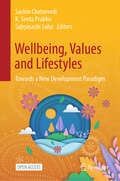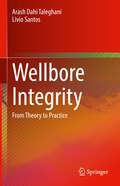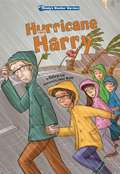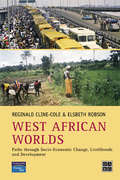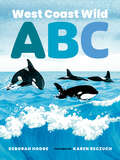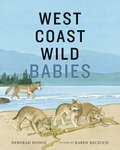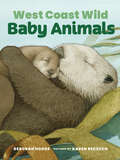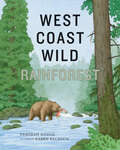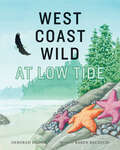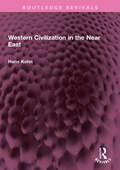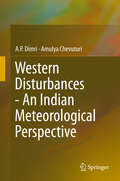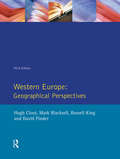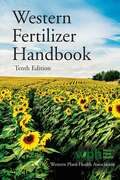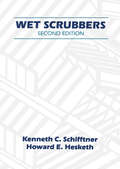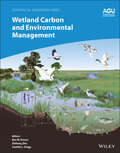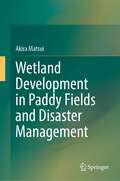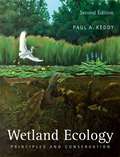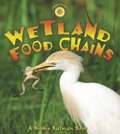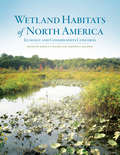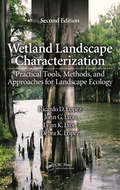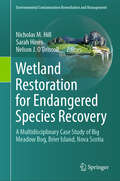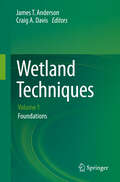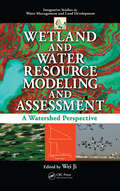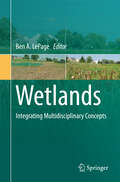- Table View
- List View
Wellbeing, Resilience and Sustainability: The New Trinity of Governance (Building a Sustainable Political Economy: SPERI Research & Policy)
by Jonathan Joseph J. Allister McGregorWellbeing, resilience and sustainability are three of the most popular ideas in current usage and are said to represent a much-needed paradigm shift in political and policy thinking. This book is unique in bringing the three concepts together as representing a new trinity of governance. Here we introduce some of the commonalities between the ideas, particularly their concern with distinctive human capacities that shape who we are and that imply a particular relationship to our wider social and natural environments. The book explains what is distinctive about the three ideas and why they are currently popular. In particular, we are concerned with how these ideas contribute to governance ‘after the crisis’, and how questions of social, political and economic uncertainty influence the ways in which these main arguments are developed. The book will appeal to those studying these ideas, how they apply to politics, political economy and governance, and to the wider public and policy-makers in these fields.
Wellbeing, Values and Lifestyles: Towards a New Development Paradigm
by Sachin Chaturvedi Sabyasachi Saha K. Seeta PrabhuThis open access book with contributions by leading global experts from diverse specialization defines a new development paradigm built on Lifestyle for Environment (LiFE). The volume outlines the contours of LiFE across five facets namely ethics and value system; sustainable consumption and production; modalities of systemic transformation; financing for resilient infrastructure, cities and societies; and wellbeing measurement going beyond GDP. The book prepared as part of the Think 20 (T20) India Task Force 3 on “LiFE, Resilience and Values for Wellbeing” presents deep insights on socio-economic transformation and ecological balance from a multi-disciplinary perspective. It highlights the importance of normative frameworks in economic thinking, equitable access to finance and technology, role of social enterprises, and imperatives for measuring wellbeing. The book is a must-have resource for political leadership, legislators, policy makers, diplomats, and international organizations in addition to the academic community.
Wellbore Integrity: From Theory to Practice
by Arash Dahi Taleghani Livio SantosThere have been concerns about the integrity of thousands of wells drilled worldwide for different purposes ranging from oil and gas to geological carbon sequestration. This is the first book to integrate different aspects of wellbore integrity into a single volume. It looks at the energy sector's green wave movement by expanding an important topic for practitioners, regulators, and students. It is an area where petroleum and subsurface engineers will increasingly need to be involved in the future to address growing expectations regarding environmental impacts and sustainability. Coverage also includes recent developments in regulations and R&D with indications on emerging areas.Wellbore Integrity: From Theory to Practice will be a valuable resource for practicing engineers and students working on problems related to subsurface energy, subsurface disposals, and environmental impacts of oil and gas wells. In parallel, it will be a valuable reference for engineers and scientists interested in repurposing existing wells for carbon sequestration or geothermal purposes.
Wendy’s Weather Warriors: Hurricane Harry
by Kathryn LayWendy wins an essay contest and gets to take the Weather Warriors and Mr. Andrews to Galveston, Texas, to read her essay about the big 1900 hurricane in Galveston. Now a real tropical storm strikes.
West African Worlds: Paths Through Socio-Economic Change, Livelihoods and Development (Developing Areas Research Group)
by Elsbeth Robson Reginald Cline-ColeWest African Worlds provides a critical assessment of social, economic and political change in Africa’s most populous and arguably most externally focused region. With an emphasis on globalisation and modernisation, case studies and commentary are integrated throughout to highlight the concerns and issues of the region.Enriched by an impressive mix of West African voices, this text combines theory and application with policy and practice to address socio-economic change, the pursuit of livelihoods, and development within West Africa.
West Coast Wild ABC (West Coast Wild #3)
by Deborah HodgeExplore the wild and wonderful Pacific west coast from A to Z! Bears amble, cougars prowl and eagles nest in this beautiful nature alphabet book celebrating the Pacific west coast. Babies and toddlers will delight in the gorgeous watercolor illustrations and fascinating creatures that inhabit the ancient rainforest, rugged beach and majestic Pacific Ocean. Large upper and lowercase alphabet letters on each page encourage letter recognition. Key Text Features illustrations
West Coast Wild Babies (West Coast Wild #2)
by Deborah HodgeIn this second book in the West Coast Wild series, readers will meet the baby animals born in the pristine wilderness of the Pacific west coast, including land and marine mammals, fish, birds and amphibians. It’s spring on the Pacific west coast and new life is stirring! Wild babies are being born — in the ocean, on the shore and deep inside the ancient rainforest. Wolf pups, cougar kittens, bear cubs and whale calves all begin their life in the pristine wilderness of this magnificent place. Young readers will meet a fascinating group of fourteen wild baby animals — including land and marine mammals, fish, birds and amphibians — and learn about the special bonds between offspring and parents, and how the newborns move toward independence. Readers will see an extraordinary community of animals thriving in an interconnected web of life. In this second book in the West Coast Wild series, Deborah Hodge takes readers through the spectacular land and seascapes of the Pacific Rim region, introducing familiar animals such as sea otters and eagles, and lesser known species such as pelagic cormorants and rufous hummingbirds. Karen Reczuch’s beautiful illustrations are detailed and lifelike, and convey a lovely sense of warmth between the wild parents and their young. The text and art have been carefully checked for scientific accuracy. Includes a note about the Pacific west coast and the need to preserve its rare and awe-inspiring wilderness regions, as well as a list for further reading and exploration. Key Text Features further reading illustrations informational note author's note Correlates to the Common Core State Standards in English Language Arts: CCSS.ELA-LITERACY.RL.1.5 Explain major differences between books that tell stories and books that give information, drawing on a wide reading of a range of text types.
West Coast Wild Baby Animals (West Coast Wild)
by Deborah HodgeMeet the wild baby animals of the Pacific west coast! Wolf pups, bear cubs, whale calves and eaglets are thriving in the ancient rainforest, rugged beach and majestic ocean of the Pacific west coast. This sweet introduction to baby animal names and behaviours, with gorgeous watercolor scenes, will delight toddlers and babies everywhere! Key Text Features illustrations
West Coast Wild Rainforest (West Coast Wild #5)
by Deborah HodgeStep into the majestic rainforest of the Pacific west coast and discover a unique community of creatures thriving in an interconnected web of life. Towering over the sea, along the magnificent Pacific west coast, is an ancient and beautiful rainforest with a unique ecosystem that is linked in many ways. In this fourth book in the West Coast Wild series, you will find trees as tall as twenty-storey buildings, tiny seedlings sprouting on nursery logs and brightly colored salmon spawning in streams. The salmon, as a keystone species, connect the ocean to the forest and provide a rich source of food for the bears, wolves, eagles and other creatures that live in this pristine wilderness. The remains of the fish add vital nutrients to the forest, feeding the lush green plants and trees. In turn, the thick vegetation shades the streams and protects the baby salmon that hatch and swim to the sea. Author Deborah Hodge provides a clear and engaging look at the interdependence of the forest species and the fascinating cycles of nature in this rare ecosystem, while Karen Reczuch’s lavish watercolors show the rainforest teeming with life in shades of green that can only come from receiving more than ten feet of rain a year. Key Text Features illustrations author’s note further information further reading facts Correlates to the Common Core State Standards in English Language Arts: CCSS.ELA-LITERACY.RI.K.3 With prompting and support, describe the connection between two individuals, events, ideas, or pieces of information in a text. CCSS.ELA-LITERACY.RI.K.7 With prompting and support, describe the relationship between illustrations and the text in which they appear (e.g., what person, place, thing, or idea in the text an illustration depicts). CCSS.ELA-LITERACY.RI.1.3 Describe the connection between two individuals, events, ideas, or pieces of information in a text. CCSS.ELA-LITERACY.RI.1.4 Ask and answer questions to help determine or clarify the meaning of words and phrases in a text.
West Coast Wild at Low Tide (West Coast Wild #4)
by Deborah HodgeExplore the wild shoreline of the majestic Pacific west coast and discover the spectacular array of colorful creatures living in rhythm with the tides. At the edge of the Pacific Ocean, where land and sea meet, lies a narrow strip of beach called the intertidal zone. Endless tides move back and forth across the zone twice a day. A remarkable community of hardy shoreline creatures flourishes in this environment of ever-changing conditions. In this third book in the West Coast Wild series, readers will meet brightly colored sea stars, a giant Pacific octopus, busy hermit crabs, delicate sand dollars, fish that camouflage and other intriguing marine animals that a child might see on a beach walk at low tide. Author Deborah Hodge relates fascinating facts about each of the fourteen creatures, while Karen Reczuch’s vibrant watercolor illustrations bring the magnificent shoreline and its unique inhabitants to life. Includes a note about the west coast intertidal zone and safety tips for beachcombers, as well as a further reading list. Key Text Features additional information author's note explanation facts further reading illustrations Correlates to the Common Core State Standards in English Language Arts: CCSS.ELA-LITERACY.RI.K.1 With prompting and support, ask and answer questions about key details in a text. CCSS.ELA-LITERACY.RI.K.3 With prompting and support, describe the connection between two individuals, events, ideas, or pieces of information in a text.
Western Civilization in the Near East (Routledge Revivals)
by Hans KohnFirst published in 1936, Western Civilization in the Near East traces the spread and growth of Western civilization in the countries of the Levant and their immediate hinterland. The author argues that modern civilization took birth in Western Europe and then slowly spread to the rest of Europe and to all other parts of the earth, leading to the Europeanization of mankind. While Europe’s modern civilization initially enabled it to dominate the world economically and political, it also provided non-European people with the resources to ultimately resist and reject Europe’s control. This universal acculturation and the ensuing birth of a coherent and closely-knit humanity, facing similar social, economic, and cultural problems determined the new trends of world history. This book only focuses on the European contact with the Muslim East and the consequences of the contact. The language used is a reflection of its era and no offence is meant by the Publishers to any reader by this republication. This book will be of interest to students of history, political science, international relations, and geography.
Western Disturbances - An Indian Meteorological Perspective
by A. P. Dimri Amulya ChevuturiThis book examines the meteorological phenomenon known as Western Disturbances (WDs) and traces their influence on the Indian subcontinent. It fully details the unique characteristics and dynamics of these disturbances, which produce large-scale instabilities in the atmosphere over northern India due to the orographic influence of the Himalayas. The authors first present a definition of the phenomenon and then go on to detail their structure and migration. Topics include dynamics, energetics and thermodynamics; modelling studies; land-use and land-cover interactions; and WDs in the changing climate. In addition, coverage outlines how WDs interact with and influence other weather systems throughout the four seasons of Indian climate: winter, pre-monsoon, monsoon and post-monsoon. It places special emphasis on wintertime dynamics since WDs significantly contribute to the precipitation in India during this time. The authors explain why this period should be termed "Indian winter monsoon" and differentiate it from the northeast monsoon which so far is the prevalent term used in the region's meteorological parlance. Complete with detailed illustrations and case studies, this monograph will help researchers and students gain a fundamental understanding of these important storms. This knowledge is essential not only for short-term and seasonal hydrometeorological forecasting but also for the assessment of regional climate change and its impacts.
Western Europe: Geographical Perspectives
by Russell King David Pinder Mark Blacksell Hugh CloutWestern Europe provides a balanced appraisal of common characteristics and shared problems of the eighteen states lying to the west of the former Iron Curtain.
Western Fertilizer Handbook
by Western Plant Health AssociationFor almost 70 years, agronomists throughout the western United States have relied on the Western Fertilizer Handbook for the most accurate information to maintain efficient and profitable growing programs. <p><p>The Tenth Edition carries this tradition forward with continued emphasis on sustainable uses of fertilizers. The expert team of contributors has updated the book's content to address current challenges facing western agriculture. Additional material has been added on micro-irrigation; soil, water, and tissue analysis; remote sensing of crop nutrient and water status; and agronomic decision support software.
Wet Scrubbers
by Howard D. HeskethA basic technical book on the design and application of gas cleaning technologies that use liquids, first published in the 1980's and used by plant and environmental engineers, regulatory personnel, and others concerned with air pollution. The second edition enlarges the discussion on the theory of
Wetland Carbon and Environmental Management (Geophysical Monograph Series)
by Ken W. Krauss Zhiliang Zhu Camille L. StaggExplores how the management of wetlands can influence carbon storage and fluxes Wetlands are vital natural assets, including their ability to take-up atmospheric carbon and restrict subsequent carbon loss to facilitate long-term storage. They can be deliberately managed to provide a natural solution to mitigate climate change, as well as to help offset direct losses of wetlands from various land-use changes and natural drivers. Wetland Carbon and Environmental Management presents a collection of wetland research studies from around the world to demonstrate how environmental management can improve carbon sequestration while enhancing wetland health and function. Volume highlights include: Overview of carbon storage in the landscape Introduction to wetland management practices Comparisons of natural, managed, and converted wetlands Impact of wetland management on carbon storage or loss Techniques for scientific assessment of wetland carbon processes Case studies covering tropical, coastal, inland, and northern wetlands Primer for carbon offset trading programs and how wetlands might contribute The American Geophysical Union promotes discovery in Earth and space science for the benefit of humanity. Its publications disseminate scientific knowledge and provide resources for researchers, students, and professionals.
Wetland Development in Paddy Fields and Disaster Management
by Akira MatsuiThis book proposes the use of green infrastructure to balance biodiversity conservation and disaster management. Paddy fields are one example of such infrastructure and are the focus of this book. In Japan, abandoned, once-cultivated land is increasing in the paddy fields due to the aging of society and recent depopulation. The author proposes to consolidate such lands and create wetlands because the paddy fields hold water during heavy rains, which prevents floods and protects cities. This is essential, considering that extreme weather conditions have increased the risk of flood damage in Japan. Not only do such wetlands hold water during the flood season, they also provide habitats for aquatic life and places for children to learn about the natural environment. In addition, fish farming in the wetlands will provide food for many people. The increase in water disasters associated with global warming is occurring not only in Japan but globally. The proposal presented in this book will help government officials around the world, especially those involved in urban and rural planning, to consider disaster management—an idea that will be welcomed by both engineers and biologists.
Wetland Ecology
by Paul A. KeddyRichly illustrated and packed with numerous examples, this unique global perspective introduces wetland ecology from basic principles to advanced applications. Thoroughly revised and reorganised, this new edition of this prize-winning textbook begins with underlying causal factors, before moving on to more advanced concepts that add depth and context. Each chapter begins with an explanation of the basic principles covered, illustrated with clear examples. More difficult concepts and exceptions are introduced only once the general principle is well-established. Key principles are now discussed at the beginning of the book, and in order of relative importance, enabling students to understand the most important material without wading through complex theory. New chapters on wetland restoration and wetland services draw upon practical examples from around the world, providing a global context, and a new chapter on research will be particularly relevant to the advanced student planning their own studies.
Wetland Food Chains (Food Chains)
by Bobbie Kalman Kylie BurnsA wide variety of plants and animals live, visit, and feed in wetlands, but wetlands are fast disappearing. This informative book describes life in a specific wetland--the marsh. Beautiful photographs, illustrations, and text explain which plants and animals live in this habitat and how they interact with one another. Young readers will learn about* wetland herbivores, carnivores, and omnivores* how wetland animals survive the changing seasons* the importance of wetlands to migrating animals* dangers to wetlands
Wetland Habitats of North America
by Andrew H. Baldwin Darold P. BatzerWetlands are prominent landscapes throughout North America. The general characteristics of wetlands are controversial, thus there has not been a systematic assessment of different types of wetlands in different parts of North America, or a compendium of the threats to their conservation. Wetland Habitats of North America adopts a geographic and habitat approach, in which experts familiar with wetlands from across North America provide analyses and synthesis of their particular region of study. Addressing a broad audience of students, scientists, engineers, environmental managers, and policy makers, this book reviews recent, scientifically rigorous literature directly relevant to understanding, managing, protecting, and restoring wetland ecosystems of North America.
Wetland Landscape Characterization: Practical Tools, Methods, and Approaches for Landscape Ecology, Second Edition
by John G. Lyon Ricardo D. Lopez Lynn K. Lyon Debra K. LopezWetlands are, by their very nature, ephemeral and transitional, which makes them challenging to characterize. Yet the need for characterizing wetlands continues to grow, particularly as we develop a better understanding of the wealth of ecosystem services that they provide. This book provides practical tools and methods to help practitioners more effectively locate, identify, and map the extent of wetlands, and therefore better understand the importance of wetlands to society and the larger landscape. The authors address jurisdictional, regulatory, and practical applications from the scientific, engineering, and lay perspectives. Numerous techniques, examples, figures, and lessons learned supply the ideas and solutions needed for solving the complex issues associated with wetlands. This second edition has been updated throughout and includes more techniques, examples, and illustrations.
Wetland Restoration for Endangered Species Recovery: A Multidisciplinary Case Study of Big Meadow Bog, Brier Island, Nova Scotia (Environmental Contamination Remediation and Management)
by Nicholas M. Hill Sarah Hines Nelson J. O’DriscollThis book provides an overview of the history of this site and the complex effects of the hydrological and ecological changes through the landscape changes, vegetation adaptation, biovector contamination, and ultimately habitat restoration. Big Meadow Bog (Brier Island, Nova Scotia, Canada) is a wetland ecosystem with a history of human disturbance. It was ditched for small-scale blueberry production in the 1950s, which significantly altered the hydrology of the system and resulted in vegetation changes and colonization by 3000+ pairs of herring gulls by the 1980s. It is also host to the endangered plant species Eastern Mountain Avens which was the impetus for restoration of the site. This book provides the background to the restoration decisions, the monitoring and science post-restoration and the lessons learned from the science and through collaboration with government and community.
Wetland Techniques
by James T. Anderson Craig A. DavisWetlands serve many important functions and provide numerous ecological services such as clean water, wildlife habitat, nutrient reduction, and flood control. Wetland science is a relatively young discipline but is a rapidly growing field due to an enhanced understanding of the importance of wetlands and the numerous laws and policies that have been developed to protect these areas. This growth is demonstrated by the creation and growth of the Society of Wetland Scientists which was formed in 1980 and now has a membership of 3,500 people It is also illustrated by the existence of 2 journals (Wetlands and Wetlands Ecology and Management) devoted entirely to wetlands. To date there has been no practical, comprehensive techniques book centered on wetlands, and written for wetland researchers, students, and managers. This techniques book aims to fill that gap. It is designed to provide an overview of the various methods that have been used or developed by researchers and practitioners to study, monitor, manage, or create wetlands. Including many methods usually found only in the peer-reviewed or gray literature, this 3-volume set fills a major niche for all professionals dealing with wetlands.
Wetland and Water Resource Modeling and Assessment: A Watershed Perspective
by Wei JiAs a wetland of international importance located in China, the Poyang Lake Basin's incredible topographical and biological diversity has provided a congregating point for scientists from around the world to engage in cross-disciplinary research. In particular, the International Conference on Poyang Lake Complex Environment System was instrumental i
Wetlands
by Ben A. LepageThe science of wetlands and our understanding of these complex ecosystems have improved considerably. The emergence of multidisciplinary strategies is providing new opportunities and innovative approaches to address issues such as climate change and coastal protection. This book, with contributions from 19 specialists from academia, government, and industry, provides a trans-disciplinary approach to the understanding wetlands science, drawing together a wide range of expertise. Topics covered include the physical aspects that shape different wetlands around the world, as well as wetlands ecology, regulation, policy, and related social and economic issues. Featuring contributions from some of the world's leading wetlands researchers and practitioners, this book provides an invaluable resource for undergraduate and post-graduate training in all aspects of wetlands management, conservation, and construction. It is also a useful auxiliary text for researchers working across disciplines in fields such as wetlands science, law, landscape architecture, environmental engineering, conservation ecology, and related disciplines.
